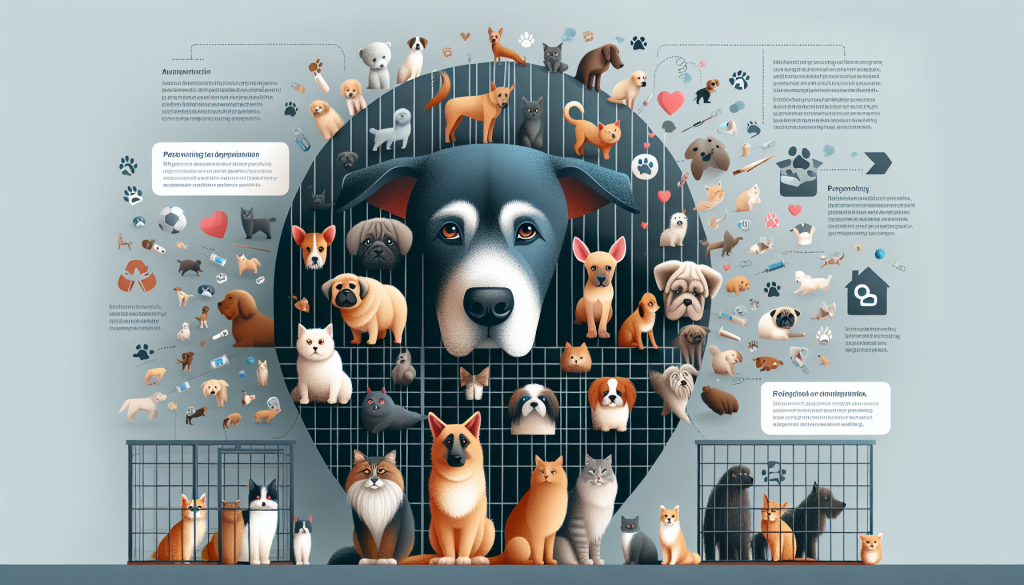Are you aware of the sad reality of pet overpopulation? Millions of animals find themselves homeless and without a loving family each year. It’s a heartbreaking issue that needs our attention. In this article, we will shed light on the truth about pet overpopulation and offer practical ways in which you can make a difference. By understanding the magnitude of the problem and taking action, we can all contribute to solving this crisis and ensure that every animal has a chance for a happy and fulfilling life.
Table of Contents
ToggleUnderstanding Pet Overpopulation
Pet overpopulation occurs when there are more animals in a given area than there are suitable homes to care for them. This issue is commonly seen with cats and dogs, and it is a problem that affects both animals and communities. Understanding the causes and impact of pet overpopulation is crucial in finding effective solutions to address this issue.
The causes of pet overpopulation
There are several factors that contribute to pet overpopulation. One of the main causes is irresponsible breeding. When pets are not spayed or neutered, they can reproduce uncontrollably. This results in a surplus of kittens and puppies that often end up in shelters or on the streets, struggling to find homes.
Another contributing factor is pet owners who fail to take responsibility for their pets. Some individuals may abandon their animals due to various reasons such as financial difficulties, moving, or simply not being able to meet the demands of pet ownership. This leads to an increase in the number of homeless animals in communities.
The impact of pet overpopulation on animals and communities
Pet overpopulation has a significant negative impact on both animals and communities. The most obvious consequence is the high number of homeless and stray animals. These animals are often left to fend for themselves, facing hunger, disease, and other dangers. Without proper care and shelter, many of them suffer and die prematurely.
Overpopulation also strains animal shelters and rescues, which often struggle to accommodate the large influx of animals. This can result in overcrowding and lack of resources, making it difficult to provide adequate care for all the animals in need. As a result, many shelters are forced to euthanize healthy animals to make space for new arrivals.
In addition to the animal welfare aspect, pet overpopulation also poses challenges for communities. Stray animals can become a nuisance, causing property damage and public health concerns. The financial burden of managing homeless animals falls on taxpayers, who end up financially supporting animal control, sheltering, and euthanasia efforts.
Spaying and Neutering: A Solution to Pet Overpopulation
Spaying and neutering pets is a crucial step in reducing and preventing pet overpopulation. By choosing to have your pet sterilized, you are actively contributing to the solution and helping to control the population of cats and dogs.
The importance of spaying or neutering your pet
Spaying and neutering have numerous benefits, not only for pet population control but also for the health and behavior of your furry companion. Sterilization eliminates the risk of unwanted litters, preventing further strain on animal shelters and rescues.
For female pets, spaying eliminates the risk of uterine infections and greatly reduces the chance of breast cancer later in life. Neutering male pets helps prevent testicular cancer and reduces the likelihood of certain behavioral issues, such as aggression and marking territory.
Benefits of spaying and neutering
Apart from the health benefits, spaying and neutering your pet can also have positive behavioral effects. Sterilized pets are generally calmer, less likely to roam, and less prone to engage in aggressive or territorial behavior. This can make them easier to train and live with, contributing to a harmonious household.
Additionally, spaying or neutering your pet early on can help prevent certain reproductive health issues from occurring. This proactive approach is essential for ensuring the long-term well-being of your furry friend while also addressing the issue of pet overpopulation head-on.
When should you spay or neuter your pet?
The optimal age for spaying or neutering your pet may vary depending on the species, breed, and individual circumstances. However, it is generally recommended to have the procedure done between the ages of four to six months.
Consulting with your veterinarian is crucial to determine the best timing for your pet. They will assess factors such as your pet’s overall health, breed-specific considerations, and discuss any potential risks or benefits associated with the timing of the surgery.
The process of spaying or neutering
Spaying and neutering procedures are routine surgeries performed by veterinarians. The surgical process involves the removal of the reproductive organs, ensuring that your pet is no longer capable of breeding.
The surgery itself is relatively quick and is performed under general anesthesia. After the procedure, your pet will need some time to recover, during which you must closely follow your veterinarian’s post-operative instructions. This may include limiting activity, providing pain management, and ensuring proper wound care.
Finding affordable spay/neuter services
Spaying or neutering your pet is an essential step in combating pet overpopulation, but cost can sometimes be a barrier for pet owners. Fortunately, there are several options available to make the procedure more affordable.
Many animal welfare organizations and clinics offer low-cost spay/neuter services. These organizations are dedicated to addressing pet overpopulation and can provide assistance to pet owners who may not be able to afford the regular cost of the procedure. Additionally, some veterinary practices offer payment plans or discounts to make spaying or neutering more accessible.
Do your research and reach out to local animal shelters, rescue organizations, or veterinary clinics to inquire about affordable spay/neuter services in your area. Taking advantage of these resources can make a significant difference in controlling pet overpopulation and ensuring the well-being of your pet.
Adopt, Don’t Shop: Ways to Help Reduce Overpopulation
Choosing to adopt a pet from a shelter or rescue organization is a powerful way to combat pet overpopulation. By giving a deserving animal a forever home, you are not only providing them with a second chance, but you are also reducing the demand for animals from breeders and pet stores.
Understanding the benefits of adopting a pet
There are numerous benefits to adopting a pet, both for you and the animal. When you adopt, you are offering a loving home to an animal in need. Many rescued animals have had difficult pasts and have faced hardships such as abuse, neglect, or abandonment. By providing them with a safe and caring environment, you are giving them the opportunity to experience love, happiness, and a brighter future.
Adopted pets often exhibit immense gratitude and loyalty towards their adoptive families. They understand that they have been given a second chance and often form deep bonds with their new owners. Adopting a pet can be an incredibly rewarding experience, as you witness the transformation of a once homeless animal into a beloved family member.
How to find reputable animal shelters and rescues
When considering adoption, it is important to choose a reputable animal shelter or rescue organization. These organizations play a vital role in caring for and rehoming homeless animals. By adopting from a reliable source, you can ensure that the animal has received proper veterinary care, behavioral assessments, and any necessary vaccinations or procedures.
Researching and visiting different shelters and rescues in your area is a great way to familiarize yourself with the available options. Take the time to ask questions, interact with the animals, and learn about each organization’s adoption process. Reputable shelters and rescues will prioritize the welfare of their animals and conduct thorough screening processes to ensure that each pet is placed in a suitable and loving home.
Consider adopting older pets or animals with special needs
While many people gravitate towards puppies and kittens when considering adoption, it is important to remember that older pets and animals with special needs also make excellent companions. These animals often have a harder time finding homes due to their age or medical conditions, but they are just as deserving of love and care.
Senior pets, for example, tend to be calmer and more settled than their younger counterparts. They require less training and are often more adaptable to various environments and lifestyles. By adopting an older pet, you are not only providing a comfortable and peaceful retirement home, but you are also gaining a wise and devoted companion.
Animals with special needs, such as physical disabilities or chronic medical conditions, can thrive in the right environment. With the right knowledge, resources, and support, these animals can lead fulfilling lives. Adopting a pet with special needs demonstrates compassion and empathy, while also giving them the opportunity to flourish.
Fostering as a temporary solution
If you are not ready to commit to pet ownership or have limited space, time, or resources, fostering can be a wonderful way to contribute to the fight against pet overpopulation. Fostering involves temporarily caring for a homeless animal until they can find a permanent home.
By becoming a foster parent, you are providing a safe and loving environment for an animal while they await adoption. This helps alleviate overcrowding in shelters and allows more animals to be rescued. Fostering can be a rewarding experience, as you play a vital role in transforming the lives of these animals and preparing them for their forever homes.
Animal shelters and rescue organizations are always in need of foster families. Reach out to your local shelter or rescue group to inquire about their fostering program and the requirements for becoming a foster parent. By opening your heart and home, you can make a profound difference in the lives of homeless animals.
Promoting Responsible Pet Ownership
Responsible pet ownership is crucial in preventing and addressing pet overpopulation. By ensuring that your pet is well-cared for and properly trained, you are setting a positive example for others and creating a safer and more harmonious community for both animals and humans.
Educating prospective pet owners
Education is key in promoting responsible pet ownership. Prospective pet owners should be equipped with the necessary knowledge and understanding of what it takes to care for a pet. This includes information about the financial responsibilities, time commitment, and emotional investment required to provide a loving and stable home.
Potential pet owners should have a clear understanding of the specific needs and characteristics of the pet they are considering. Different breeds and species have unique traits and requirements, and it is essential to match the pet’s needs with the owner’s lifestyle and capabilities.
Providing resources such as brochures, websites, and educational workshops can help prospective pet owners make informed decisions. Collaborating with local animal welfare organizations, veterinary clinics, and community centers can also be effective in reaching a wider audience and ensuring that responsible pet ownership is promoted throughout the community.
Choosing the right pet for your lifestyle
When considering adding a new pet to your family, it is essential to choose a companion that aligns with your lifestyle and living situation. Different pets have different needs, exercise requirements, and levels of companionship. By selecting a pet that suits your lifestyle, you are more likely to provide them with the care and attention they deserve.
For example, if you have a busy and active lifestyle, a high-energy dog breed may be a good fit for you. On the other hand, if you live in a small apartment or have limited mobility, a small or low-energy breed may be more suitable. Understanding your own capabilities and limitations is important in ensuring that you can meet the needs of your pet.
It is also crucial to consider the long-term commitment involved in pet ownership. Pets can live for many years, and it is essential to be prepared for the responsibilities that come with caring for them throughout their lifetime. By carefully considering your ability to provide a loving, stable, and long-term home, you can make a responsible decision when selecting a pet.
Proper care and training of pets
Once you have chosen a pet that suits your lifestyle, it is important to provide them with proper care and training. This includes meeting their basic needs such as food, water, shelter, and veterinary care. Regular exercise, mental stimulation, and socialization are also vital for your pet’s overall well-being.
Proper training is essential in ensuring that your pet behaves appropriately and becomes a well-adjusted member of society. Basic obedience training, housebreaking, and socialization are important aspects of pet ownership. Positive reinforcement techniques, such as rewards and praise, can be highly effective in shaping desired behaviors and fostering a strong bond with your pet.
It is important to note that responsible pet ownership includes spaying or neutering your pet, as discussed earlier. By taking this step, you are actively contributing to the solution of pet overpopulation. Additionally, maintain regular veterinary check-ups and vaccinations to prevent health issues and keep your pet in optimal condition.
The importance of pet identification and microchipping
Another important aspect of responsible pet ownership is ensuring that your pet can be properly identified and reunited with you if they become lost. Collars with ID tags containing your contact information are a common form of identification. However, collars can come off or be removed, leaving your pet without any identification.
Microchipping is a more permanent form of identification and is a widely recommended practice. A microchip is a small electronic device implanted under your pet’s skin. It contains a unique identification number that can be scanned by a veterinarian or animal shelter if your pet is found. Registering the microchip with your contact information ensures that you can be contacted and reunited with your pet if they are ever lost or stolen.
Microchipping is a quick and relatively painless procedure that can greatly increase the chances of your pet being returned to you if they become separated from you. Consult with your veterinarian to determine the best time to microchip your pet and ensure that their information remains up to date in the microchip registry.
Supporting Animal Welfare Organizations
Animal welfare organizations play a vital role in addressing pet overpopulation and providing care to homeless animals. By supporting these organizations, you can actively contribute to their efforts and help make a difference in the lives of animals in need.
Volunteering at local animal shelters or rescues
One of the most direct ways to support animal welfare organizations is by volunteering your time and skills at local animal shelters or rescues. These organizations often rely heavily on the help of volunteers to provide care, socialization, and enrichment for their animals.
Tasks can vary and may include cleaning, feeding, walking dogs, providing basic grooming, or assisting with administrative work. By volunteering, you not only help improve the lives of the animals in the shelter but also contribute to the overall functioning of the organization.
Volunteering can be a rewarding and fulfilling experience, as you directly witness the impact of your efforts. It also provides an opportunity to learn more about animal behavior, welfare issues, and the challenges faced by animal welfare organizations. Reach out to your local shelter or rescue group to inquire about volunteer opportunities and how you can get involved.
Donating to support spay/neuter programs
Financial contributions are crucial in supporting spay/neuter programs and initiatives aimed at addressing pet overpopulation. Many animal welfare organizations offer low-cost or subsidized spay/neuter services to pet owners who may not be able to afford the regular cost of the procedure.
By donating to these programs, you can help ensure that more pets can be sterilized and contribute to the long-term solution of pet overpopulation. Even small donations can make a difference and help fund these vital services.
Research local animal welfare organizations, veterinary clinics, or spay/neuter programs that are actively involved in addressing pet overpopulation. Reach out to them to inquire about donation opportunities and how your contribution can be used to support their efforts in the community.
Fundraising and awareness campaigns
Fundraising and awareness campaigns play a crucial role in supporting animal welfare organizations and promoting the importance of addressing pet overpopulation. These initiatives help raise funds for critical programs and services and also help educate the public about the issue at hand.
Consider organizing or participating in fundraising events such as walks, runs, or auctions, with the proceeds going toward spay/neuter programs or other animal welfare initiatives. Engage your community, friends, and family to support these events and spread awareness about the importance of responsible pet ownership.
Social media platforms offer a powerful tool for raising awareness and reaching a broad audience. Utilize these platforms to share educational content, success stories, and information about local animal welfare organizations. Encourage your friends and followers to share the content, spreading the message further and helping to educate others about pet overpopulation.
Advocacy for stronger animal protection laws
Advocacy plays a crucial role in driving legislative changes to address pet overpopulation and improve animal welfare. By voicing your concerns and supporting initiatives for stronger animal protection laws, you can contribute to creating a society that values the well-being and rights of animals.
Stay informed about proposed legislation in your area that relates to animal welfare, pet ownership, or spay/neuter programs. Contact your local representatives and express your support for initiatives aimed at combating pet overpopulation and improving the lives of animals. Joining or supporting animal advocacy organizations can also provide a platform to make your voice heard on a larger scale.
By advocating for stronger animal protection laws, you are helping create an environment where responsible pet ownership is encouraged, and the cycle of pet overpopulation is broken.
Community Initiatives to Address Pet Overpopulation
Addressing pet overpopulation requires not only individual efforts but also collaborative initiatives within communities. By working together, communities can implement effective programs and policies that have a lasting impact on reducing the number of homeless animals.
Trap-Neuter-Return (TNR) programs for community cats
One effective community initiative to address pet overpopulation, particularly in relation to feral and stray cats, is a Trap-Neuter-Return (TNR) program. These programs involve trapping feral and stray cats, sterilizing them, and then returning them to their original location.
TNR programs help control the population of community cats by preventing further breeding. These cats are often not suitable for adoption due to their feral nature, but by sterilizing them, the population can be managed and their quality of life improved.
Collaborating with local animal welfare organizations, veterinary clinics, and community members is crucial in implementing successful TNR programs. By combining efforts and resources, communities can ensure that community cats are not only sterilized but also provided with medical care, food, and shelter.
Collaboration with veterinary clinics for discounted services
Collaboration with veterinary clinics is essential in addressing pet overpopulation. By partnering with local clinics, communities can establish discounted spay/neuter services and other necessary veterinary care for low-income pet owners.
Veterinary clinics can support these efforts by providing their services at reduced rates or by offering specific days or times dedicated to discounted procedures. This helps remove financial barriers that may prevent pet owners from having their animals sterilized, ultimately contributing to the solution of pet overpopulation.
Community organizations, shelters, and rescues can play a crucial role in facilitating these collaborations by acting as liaisons between veterinary clinics and pet owners in need. By connecting pet owners with the necessary resources and services, communities can ensure that more animals are spayed or neutered, contributing to the long-term solution of pet overpopulation.
Government partnerships and legislation
Strong government partnerships and legislation are essential in addressing pet overpopulation on a larger scale. Governments can play a vital role by providing funding and support for spay/neuter programs, as well as implementing regulations and laws that promote responsible pet ownership.
Working with local government officials, animal welfare organizations, and concerned community members can help drive legislative changes. This may include advocating for mandatory spay/neuter laws, limits on the number of pets allowed per household, or stricter breeding regulations.
By participating in local government meetings, voicing concerns, and supporting initiatives that address pet overpopulation, you can contribute to creating a community that prioritizes the welfare of animals and takes an active stance against pet overpopulation.
Educational programs in schools and communities
Implementing educational programs in schools and communities is a proactive approach to addressing pet overpopulation. By educating the younger generation and the wider community about responsible pet ownership and the consequences of pet overpopulation, we can foster a more compassionate society.
Schools can incorporate curriculum modules or guest speakers from animal welfare organizations to raise awareness among students. Topics can include the importance of spaying/neutering, the benefits of adoption, and the responsibilities of pet ownership.
Community centers, libraries, and local events are excellent platforms to host educational workshops or seminars. By providing resources, information, and expert advice, communities can empower individuals to make informed decisions about pet ownership and contribute to addressing the issue of pet overpopulation.
The Role of Veterinarians in Combating Pet Overpopulation
Veterinarians play a critical role in combatting pet overpopulation. Their expertise and services are vital in providing accessible spay/neuter services and educating pet owners about responsible pet ownership.
Providing accessible spay/neuter services
Veterinarians are at the forefront of providing spay/neuter services to pet owners. By offering these services in their clinics, they create accessible options for community members who wish to have their pets sterilized.
Veterinarians can work with local animal welfare organizations, community initiatives, and government partnerships to establish affordable spay/neuter programs. Collaborations can provide funding, resources, and networking opportunities, ensuring that more pets can be sterilized and the cycle of pet overpopulation can be broken.
Educating pet owners on responsible pet ownership
Veterinarians have a unique opportunity to educate pet owners about the importance of responsible pet ownership. During routine check-ups and vaccinations, they can provide guidance on proper nutrition, exercise, vaccination schedules, and behavior training.
By addressing preventive care and the importance of spaying/neutering, veterinarians can actively contribute to efforts aimed at controlling pet overpopulation. They can provide information about the benefits of sterilization, dispel common myths or misconceptions, and address any concerns or questions pet owners may have.
Building a strong relationship between veterinarians and pet owners allows for ongoing education and support. This collaboration ensures that pet owners are equipped with the knowledge and resources to provide the best possible care for their furry companions.
Participating in low-cost vaccination and microchipping clinics
In addition to spay/neuter services, veterinarians can also participate in low-cost vaccination and microchipping clinics. Providing these services at reduced rates or during specific events helps ensure that more pets have access to essential preventive care.
Regular vaccinations help prevent the spread of diseases, while microchipping improves the chances of lost pets being reunited with their owners. By offering these services at a lower cost, veterinarians contribute to the overall well-being of pets and promote responsible pet ownership within the community.
Collaborating with local animal welfare organizations, clinics, and veterinary associations can help establish these clinics and ensure that resources are available to pet owners who may not have access to regular veterinary care.
Supporting Pet Overpopulation Awareness
Creating awareness about pet overpopulation is crucial in driving change and inspiring action within communities. By actively promoting the importance of responsible pet ownership and the need for spaying/neutering, you can help make a difference in the lives of animals.
Spreading awareness through social media
Social media platforms offer a powerful tool for spreading awareness about pet overpopulation. Utilize these platforms to share educational content, success stories of adopted pets, and information about local animal shelters and rescues. Engage your friends and followers by sharing personal experiences, tips for responsible pet ownership, and the importance of spaying/neutering.
Collaborate with local animal welfare organizations and veterinary clinics to create engaging and informative social media campaigns. Incorporate hashtags, share statistics, and encourage others to share their own stories and experiences. By leveraging the reach and influence of social media, you can help educate a broader audience and inspire them to take action.
Organizing and participating in local events
Organizing or participating in local events is another effective way to raise awareness about pet overpopulation. Pet adoption fairs, fundraising events, and educational workshops can all contribute to the overall message of responsible pet ownership and the importance of spaying/neutering.
Collaborate with local animal shelters, rescue organizations, and community centers to plan and execute these events. Engage local businesses, schools, and community groups to participate and raise awareness within their networks.
Utilize various outlets to promote these events, such as local newspapers, radio stations, community bulletin boards, and online event listings. By creating engaging and informative experiences, you can captivate the attention of the community and encourage them to take an active role in combating pet overpopulation.
Creating educational materials and resources
Developing educational materials and resources is an effective approach to reach a broader audience and disseminate information about pet overpopulation. This can include brochures, pamphlets, infographics, and videos that highlight the importance of spaying/neutering and responsible pet ownership.
Collaborate with local animal welfare organizations, veterinary clinics, and educational institutions to create these materials. Distribute them at community events, local businesses, schools, and veterinary clinics to ensure maximum exposure.
Engage with local media outlets to share these resources and promote responsible pet ownership. Newspapers, radio stations, and online platforms often welcome educational and informative content, allowing you to reach a wider audience and inspire others to join the cause.
Addressing Pet Overpopulation in Different Settings
The issue of pet overpopulation is present in various settings, each with its own unique challenges and considerations. By recognizing these differences and tailoring solutions to specific settings, we can effectively address pet overpopulation within different communities.
Urban areas and the challenges they face
Urban areas often present unique challenges in addressing pet overpopulation. High population density, limited open spaces, and an increased transient population can contribute to the growing number of homeless and stray animals.
In urban settings, collaboration between local government, animal welfare organizations, businesses, and community members is crucial. Implementing aggressive spay/neuter programs, establishing outreach initiatives to educate transient populations, and providing accessible pet care services can help control pet overpopulation in urban areas.
Creating designated dog parks, implementing stricter leash laws, and promoting responsible pet ownership through community events are other effective measures in urban areas. By working together to address these challenges, urban communities can create safer, more animal-friendly environments.
Rural communities and the specific issues they encounter
Rural communities face their own set of challenges when it comes to pet overpopulation. The vastness of rural areas and the prevalence of working animals can contribute to loose breeding and an increased population of unowned animals.
In rural settings, outreach and education play a crucial role. Collaborating with local farmers, agricultural associations, and community leaders can help raise awareness about responsible pet ownership and the benefits of spaying/neutering.
Providing mobile spay/neuter clinics and veterinary care that can reach remote areas is essential in reducing pet overpopulation in rural communities. Establishing partnerships between veterinary clinics and community organizations can help provide these services more efficiently and effectively.
Considerations for pet overpopulation in developing countries
Pet overpopulation is a significant issue in many developing countries. Factors such as limited resources, lack of access to veterinary care, and cultural attitudes towards pet sterilization contribute to the proliferation of homeless animals.
Addressing pet overpopulation in developing countries often requires a multi-faceted approach. Establishing mobile veterinary clinics, training local veterinarians and staff, and educating communities about the benefits of spaying/neutering are important steps.
Collaborating with local organizations and governments to implement subsidized spay/neuter programs and improve animal welfare legislation is also crucial. By addressing the cultural and economic factors specific to each region, sustainable solutions can be implemented to combat pet overpopulation and improve the lives of animals in developing countries.
Taking Action: What You Can Do to Help
As an individual, you have the power to make a difference in the fight against pet overpopulation. By taking action and inspiring others to join the cause, we can work towards creating a world where every pet has a loving and permanent home.
Getting involved with local animal welfare organizations
One of the most impactful steps you can take is to get involved with local animal welfare organizations. Volunteer your time and skills at animal shelters, rescue organizations, or spay/neuter clinics.
By assisting with daily care tasks, organizing fundraising events, or participating in community outreach programs, you can actively contribute to the well-being of homeless animals and support initiatives aimed at reducing pet overpopulation.
Spaying/neutering your own pets
A responsible pet owner leads by example. By having your own pets spayed or neutered, you are actively participating in the solution to pet overpopulation.
Consult with your veterinarian to determine the best time for the procedure and discuss any concerns or questions you may have. By taking this important step, you are not only ensuring the well-being of your own pet but also preventing unwanted litters and helping to control the overall population of cats and dogs.
Educating others about pet overpopulation
Education is a powerful tool in combating pet overpopulation. Take the initiative to educate your friends, family, and community about the importance of responsible pet ownership and the benefits of spaying/neutering.
Share resources, information, and personal experiences to help raise awareness and dispel common myths or misconceptions. By empowering others with knowledge, you can inspire them to make informed decisions and actively contribute to the solution.
Supporting policies and programs that address the issue
By supporting policies and programs that address pet overpopulation, you can help create a more compassionate and responsible society. Stay informed about proposed legislation and initiatives in your area and voice your support to local representatives.
Attend community meetings, participate in public consultations, or sign petitions related to pet overpopulation. By actively engaging in these processes, you can make a difference and contribute to shaping policies that have a positive impact on animal welfare.
In conclusion, addressing pet overpopulation requires a multi-faceted approach involving responsible pet ownership, community initiatives, collaboration with veterinarians and animal welfare organizations, and support from governments. By understanding the causes and impact of pet overpopulation, promoting spaying/neutering and adoption, supporting educational programs, and advocating for stronger laws, we can work together to create a world where every pet has a loving and permanent home. Your involvement and commitment to the cause are crucial in making this vision a reality.








